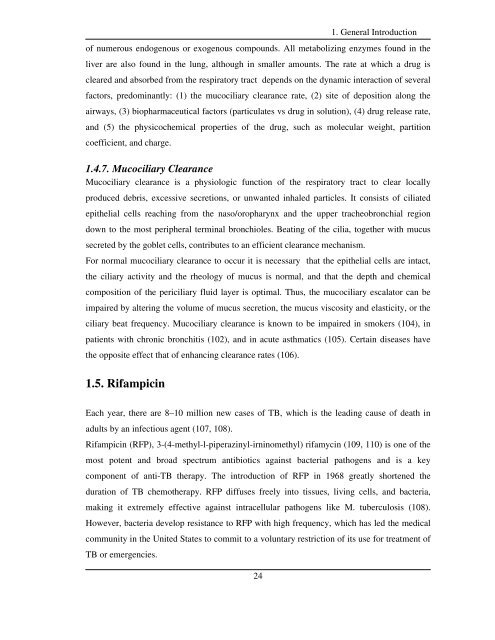chitosan and plga microspheres as drug delivery ... - UniCA Eprints
chitosan and plga microspheres as drug delivery ... - UniCA Eprints
chitosan and plga microspheres as drug delivery ... - UniCA Eprints
Create successful ePaper yourself
Turn your PDF publications into a flip-book with our unique Google optimized e-Paper software.
1. General Introductionof numerous endogenous or exogenous compounds. All metabolizing enzymes found in theliver are also found in the lung, although in smaller amounts. The rate at which a <strong>drug</strong> iscleared <strong>and</strong> absorbed from the respiratory tract depends on the dynamic interaction of severalfactors, predominantly: (1) the mucociliary clearance rate, (2) site of deposition along theairways, (3) biopharmaceutical factors (particulates vs <strong>drug</strong> in solution), (4) <strong>drug</strong> rele<strong>as</strong>e rate,<strong>and</strong> (5) the physicochemical properties of the <strong>drug</strong>, such <strong>as</strong> molecular weight, partitioncoefficient, <strong>and</strong> charge.1.4.7. Mucociliary ClearanceMucociliary clearance is a physiologic function of the respiratory tract to clear locallyproduced debris, excessive secretions, or unwanted inhaled particles. It consists of ciliatedepithelial cells reaching from the n<strong>as</strong>o/oropharynx <strong>and</strong> the upper tracheobronchial regiondown to the most peripheral terminal bronchioles. Beating of the cilia, together with mucussecreted by the goblet cells, contributes to an efficient clearance mechanism.For normal mucociliary clearance to occur it is necessary that the epithelial cells are intact,the ciliary activity <strong>and</strong> the rheology of mucus is normal, <strong>and</strong> that the depth <strong>and</strong> chemicalcomposition of the periciliary fluid layer is optimal. Thus, the mucociliary escalator can beimpaired by altering the volume of mucus secretion, the mucus viscosity <strong>and</strong> el<strong>as</strong>ticity, or theciliary beat frequency. Mucociliary clearance is known to be impaired in smokers (104), inpatients with chronic bronchitis (102), <strong>and</strong> in acute <strong>as</strong>thmatics (105). Certain dise<strong>as</strong>es havethe opposite effect that of enhancing clearance rates (106).1.5. RifampicinEach year, there are 8–10 million new c<strong>as</strong>es of TB, which is the leading cause of death inadults by an infectious agent (107, 108).Rifampicin (RFP), 3-(4-methyl-l-piperazinyl-irninomethyl) rifamycin (109, 110) is one of themost potent <strong>and</strong> broad spectrum antibiotics against bacterial pathogens <strong>and</strong> is a keycomponent of anti-TB therapy. The introduction of RFP in 1968 greatly shortened theduration of TB chemotherapy. RFP diffuses freely into tissues, living cells, <strong>and</strong> bacteria,making it extremely effective against intracellular pathogens like M. tuberculosis (108).However, bacteria develop resistance to RFP with high frequency, which h<strong>as</strong> led the medicalcommunity in the United States to commit to a voluntary restriction of its use for treatment ofTB or emergencies.24
















